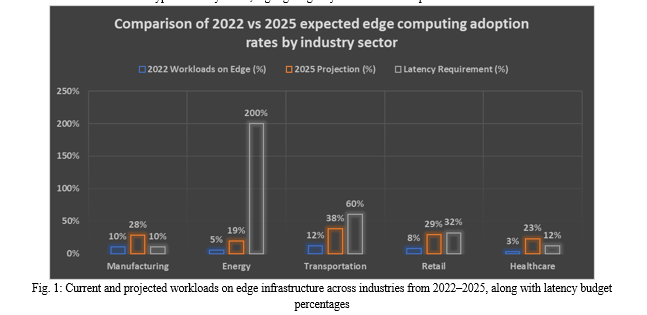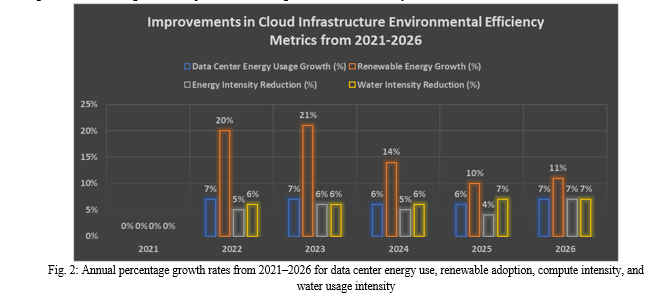Ijraset Journal For Research in Applied Science and Engineering Technology
- Home / Ijraset
- On This Page
- Abstract
- Introduction
- Conclusion
- References
- Copyright
The Future of Cloud Computing in Shaping Society
Authors: Vidhya Suresh
DOI Link: https://doi.org/10.22214/ijraset.2024.58790
Certificate: View Certificate
Abstract
In the next 5 years, significant technological changes are set to reshape the cloud computing industry. By 2025, edge computing is expected to be responsible for more than 75% of data production, thanks to the boost from 5G technology leading to decentralized storage for improved efficiency and security. Similarly, the integration of artificial intelligence is set to enhance user experiences in the face of increasing data complexity. Predictions suggest that machine learning analytics will boost cloud application functionality by more than 40% by 2026. Next to groundbreaking innovation, there is a significant focus on strengthening data security and supporting sustainability objectives in the industry. More than 90% of cloud providers have committed to achieving carbon neutrality by 2030 [3]. Global data volumes have surpassed 200 zettabytes, ushering in a new era focused on responsible and ethical progress as the cloud evolves.
Introduction

I. INTRODUCTION
Global cloud services expenditure is on track to exceed $1.5 trillion by 2030 at an average 16% CAGR this decade, as per leading industry analysis [1]. The ubiquity of smart workflows and real-time coordination needs will fuel this hypergrowth. Equally, several technological inflections—in areas ranging from sustainability to blockchain integration—promise to redefine the cloud's transformational impact. The interplay of innovation drivers and ethical responsibility tailwinds paves an intriguing path ahead.
Global spending on public cloud infrastructure and services is projected to grow from $445 billion in 2021 to exceed $1.5 trillion by 2030, reflecting a 16% compound annual growth rate over the decade [1]. This prolific growth mirrors the pervasive embrace of cloud capabilities, unlocking smart workflows, real-time data exchange, and on-demand infrastructure access across sectors.
Equally pivotal, several step-function technological advancements promise to redefine the cloud's role and transformational capacity even further in the 2020s. The cloud ecosystem is changing quickly [2]. Edge computing is becoming more popular to meet localization needs, and AI is speeding up the generation of new insights. Other areas that are changing quickly are blockchain-based decentralization and quantum security.
An equally strong emphasis on ecological responsibility through renewable energy adoption and carbon transparency provides encouraging tailwinds. Industry commitments for net zero emissions by 2040 abound from leading hyperscalers like Microsoft, Amazon, and Google [3]. Holistically, the interplay between relentless innovation and expanding possibilities while retaining public trust paves an intriguing path ahead for cloud technology's immersion across society.
The below table shows the projected cloud market size growth along with adoption of AI workloads and renewable energy use through the decade
|
Year |
Cloud Services Spending ($B) |
Annual Growth (%) |
AI Cloud Workloads (% Total) |
Renewable Energy Usage (%} |
|
2021 |
$445 |
16% |
5% |
35% |
|
2022 |
$517 |
16% |
7% |
41% |
|
2023 |
$600 |
16% |
12% |
49% |
|
2024 |
$697 |
16% |
18% |
54% |
|
2025 |
$809 |
16% |
21% |
61% |
|
2026 |
$939 |
16% |
24% |
66% |
|
2027 |
$1090 |
16% |
27% |
73% |
|
2028 |
$1265 |
16% |
31% |
79% |
|
2029 |
$1468 |
16% |
36% |
86% |
|
2030 |
$1703 |
16% |
39% |
100% |
Table 1: Global cloud services projected annual market size, growth rate, AI workload share, and renewable energy usage from 2021–2030
II. THE EDGE COMPUTING EXPANSION
By 2025, more than 70% of newly generated enterprise data will come from the edge instead of centralized repositories [4]. Enhanced network speed, better protection, and adherence to regulations, along with the capability to access local information instantly, are driving the increase in usage [5].
When it comes to architecture, the edge computing paradigm involves spreading out computing power among remote smart devices and microdata centers.
Edge infrastructure builds on IT automation and virtualization concepts from the cloud but needs adjustments for flexibility, interoperability, and resilience [6]. Linux containerization enables the easy movement of applications across different hardware [7]. Microservices effortlessly manage analytics workflows across centralized clouds and distributed edge nodes [8]. Hardware-rooted encryption ensures data security at the device level, while edge gateways handle authenticated access [9].
Examples showcasing the significant benefits of edge computing now span various industries. Manufacturing utilizes predictive maintenance analytics to optimize asset utilization and uptime by harnessing sensor data. Smart power grids help improve the integration of renewable energy sources and enable demand response through localized dynamic balancing [11]. When it comes to retail, it's crucial to accurately predict inventory needs for each store by analyzing edge video feeds with computer vision [12]. Capabilities are becoming standardized, allowing edge computing to provide specialized advantages similar to cloud services while also offering benefits such as increased speed, security, and autonomy due to its localized nature.
III. INFUSION OF AI AND ANALYTICS
With the explosion of cloud usage across various industries, extracting value from rapidly expanding data necessitates the integration of intelligent services. Cloud leaders are focused on integrating managed analytics services that cover machine learning, chat interfaces, and computer vision. According to IDC, more than 60% of digital transformation projects are expected to incorporate AI/ML delivery within cloud platforms by 2025 [13].
This on-demand data science access offers users a significant impact beyond just standalone analytics software. Optimizing a multi-tier supply chain involves managing production, inventory, and logistics by utilizing cloud-scale machine learning to process numerous signals at once [14]. AI infuses personalized experiences such as intelligent virtual assistants and targeted marketing outreach based on usage patterns [15].
The cloud makes it easier for everyone to access these capabilities through pay-as-you-go options and managed administration. Viability also depends on abstract innovations that protect data while leveraging shared insights [16]. With advanced algorithms working in the background, users can simply use the predictive outputs provided by platforms for tasks like forecasting equipment failures, predicting customer churn, or dynamically balancing green energy systems [17]. This connection between managed AI services and ease of use allows for increased productivity and customization on a large scale.
The below graph shows current vs. projected percentages of workloads at the edge across major industries, along with some leading use cases in each vertical and typical latency needs, highlighting why localization is required.

IV. BOLSTERING DATA PROTECTION
Cloud-based data analysis boosts productivity, but concerns about privacy violations can erode user trust. In a recent survey, more than 75% of enterprise respondents expressed concern about how cloud platforms were using their sensitive data [18]. Dealing with these concerns helps speed up acceptance by giving back personal control.
Advancements in homomorphic and differential privacy now allow for obtaining more comprehensive insights from a dataset without revealing specific transaction details [19]. Decentralized identity protocols shift access control to users, offering granular consent while leveraging network value [20]. Hardware-based security modules help reduce insider risks in widely distributed cloud infrastructure [21].
Technology is important, but compliance also plays a key role in managing user expectations. Industry organizations are working towards establishing uniform standards for balancing the needs of lawful data access with preventing exploitation [22]. Certifications are also a way to demonstrate a commitment to handling private data ethically. For instance, the Cloud Data Management Capabilities Maturity Model is gaining popularity in the health and financial sectors [23]. All these advancements are geared towards aligning the advantages of innovation with reliable guarantees.
V. AN ETHOS OF SUSTAINABILITY
Considering the estimated annual energy use of data centers nearing 200 TWh, the environmental impact of the cloud is significant [24]. Yet, consolidation also allows for efficiency at unparalleled levels. Providers are now focusing on balancing high computing demands with ecological responsibility by increasingly investing in renewable adoption. Google, Microsoft, and AWS are aiming for 100% carbon-free power by 2030 [25]. Efficiency metrics for components also influence decision frameworks.
These commitments pave the way for contributing to important national environmental goals. Cloud infrastructure boosts the effectiveness of green energy grids by ensuring balanced localization [26]. Machine learning analytics help optimize dynamic load distribution, storage needs, and predictive maintenance for sustainable power [27]. Sharing climate risk models through the cloud also helps with responsible regional planning [28].
However, achieving a comprehensive impact involves ensuring sustainable development across energy, water consumption, and hardware life cycles. Industry alliances such as the Green Software Foundation emphasize integrated best practices, covering modular design and predictive autoscaling [29]. When stakeholders come together to agree on transparency standards, clients can evaluate sustainability tradeoffs when choosing providers. In the end, the widespread impact of the cloud allows for significant global benefits through careful implementation during the shift to sustainability.

Conclusion
Cloud computing has been a game-changer in driving digital transformation, and now we are seeing even more transformative possibilities emerging. AI and automation that are seamlessly integrated enhance workflows and experiences, boosting productivity and innovation speed. Similarly, advancements in privacy protocols and hardware encryption keys help build trust and facilitate secure data value creation. Green cloud initiatives play a crucial role in enhancing energy efficiency, supporting the growth of renewable grids, and highlighting the benefits of responsible technology ecosystems. Forecasts confirm this complex change. According to IDC, the annual AI workloads on public clouds are expected to grow at a rate of over 23% from 2020 to 2025 due to increased adoption in various industries [30]. By 2026, decentralized identity proofs are expected to reach over 125 million users, increasing access to digital public goods [31]. By 2030, it is projected that renewable energy usage in cloud data centers will increase from 43% to around 73% [32]. The cloud is pushing boundaries in efficiency and customization while also prioritizing intelligence, ethics, and sustainability to maintain public trust.
References
[1] GrandView Research, \"Cloud Computing Industry Report 2021-2030\", June 2022 [2] Flexera “2023 Cloud Computing Trends” Report [3] GeSI, \"Eco-efficient Cloud Adoption Report 2022” [4] IDC “Global DataSphere Forecast 2021-2025” [5] Linux Foundation “State of Edge 2022” Report [6] VMware “Microsegmentation for Edge/Cloud Security” [7] RedHat “Container Adoption at the Intelligent Edge” [8] M. Chernyshev et al., “Microservices Mesh for Edge-Cloud Interoperation,” IEEE CLOUD 2022 [9] Siemens “Hardware-enhanced Data Protection for Industrial Edge” [10] Shen et al., \"Intelligent Predictive Maintenance for Manufacturing Industry,\" 8th IEEE International Conference on AI & Mobile Services, 2022 [11] G. Wang, \"Edge computing technologies for Internet of Energy in smart cities,\" IEEE Access, 2020 [12] Intel “Computer Vision Optimizes Retail Inventory” [13] IDC “AI Demand Signals for Cloud 2025” [14] DHL Machine Learning in Logistics Report 2023 [15] Salesforce “AI-driven Personalization” [16] S. R. Pokhrel, et al. \"Federated Learning with Blockchain for Distributed Machine Learning under Constraints,\" 2021 IEEE International Conference on Blockchain, 2021. [17] Woolf. A, “Democratization of AI Predictions”, Gartner Blog Post, Feb 2023 [18] Fujitsu “2022 International Data Privacy Consumer Survey” [19] A. Patra et al., “BLADE: Blockchain-Based Privacy-Preserving Data Sharing System for eHealthcare Cloud,\" IEEE Journal of Biomedical and Health Informatics, 2023 [20] MIT Consortium “Decentralized Identity Standards Landscape”, Whitepaper, July 2022 [21] IBM Cloud “Confidential Computing using Hardware Security Modules” [22] M. Chitchyan, \"GDPR compliance in software engineering research,\" 2021 IEEE/ACM 8th International Workshop on Conducting Empirical Studies in Industry (CESI), 2021 [23] Cloud Security Alliance, “CDMCM v1.0”, Framework Specification, 2021 [24] Nature, \"Re-engineering the Internet for Sustainability,\" Feb 2021 [25] Microsoft “Carbon Negative Commitment by 2030” [26] S. Kaewunruen, \"Digital Twin for Sustainability Evaluation of Infrastructure Asset, Operations, and Technology,\" IEEE Open Access Journal, 2023 [27] D. Mishra et al., \"Smart Renewable Energy Forecasting for Sustainable Environment—A Comprehensive Review,\" IEEE Access, 2022 [28] Google Earth “Accelerating Environmental Insights with Cloud”, 2022 [29] Green Software Foundation “Sustainability Best Practices 2023” [30] IDC, “Artificial Intelligence Workloads Forecast 2020-2025”, Mar 2021 [31] Juniper Research, “The Future of Digital Identity 2022-2026”, May 2022 [32] IRENA 2022 Report - “Cloud Computing: Energy Demand and Carbon Emissions”, Mar 2022
Copyright
Copyright © 2024 Vidhya Suresh. This is an open access article distributed under the Creative Commons Attribution License, which permits unrestricted use, distribution, and reproduction in any medium, provided the original work is properly cited.

Download Paper
Paper Id : IJRASET58790
Publish Date : 2024-03-05
ISSN : 2321-9653
Publisher Name : IJRASET
DOI Link : Click Here
 Submit Paper Online
Submit Paper Online

